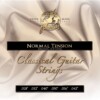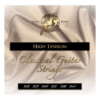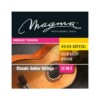Classical Guitar Strings
Which classical guitar strings to choose?
The strings of acoustic instruments such as the classical guitar are of vital importance since, after the performer, the woods and the construction, they are the most important element for the character of the sound.
The peculiarity of classical guitar strings is that the first three strings (E,B,G) are usually made of a single filament or thread (either nylon, carbon or titanium) while the last three are called “multifilament” because several strands are used, usually wound to an inner core constructed of some flexible material.
Classical Guitar Strings Tension
When choosing the type of tension (basically the force exerted by the string from the bridge to the nut) we must analyze our playing technique and the characteristics of the instrument in which we are going to use them.
The harder the tension, the fuller the sound, but it feels harder to the hand. The softer the tension, the duller the sound but it feels smoother to the hand. A rule of thumb is usually to reserve the high tension strings for performing life or when playing percussive styles such as flamenco. We can use soft or medium tension to study or practice, or in case we do not have enough strength in the hand, which can prevent injury. But, as always, the best is to try different ones until we find the one that best suits our needs.


